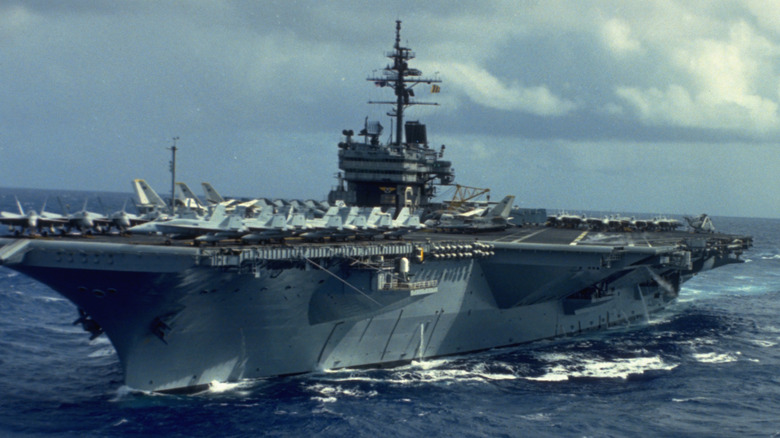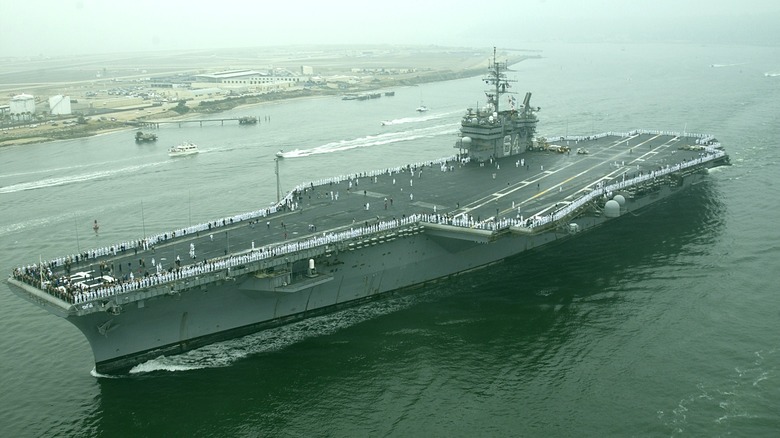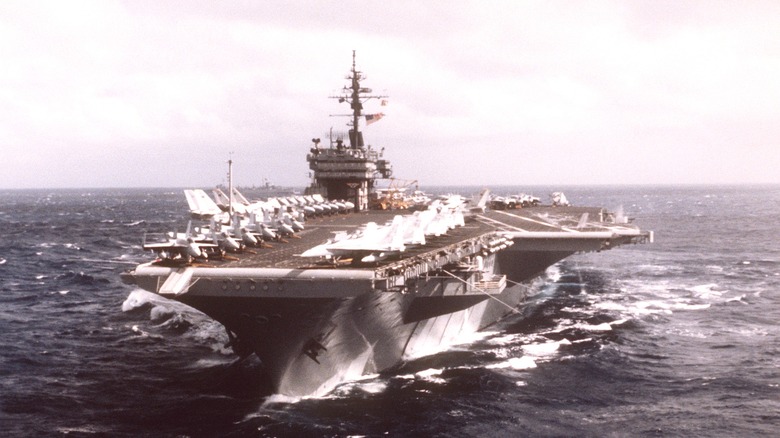What Happened To The USS Constellation Aircraft Carrier: Where Is CV-64 Now?
The USS Constellation (CV-64) was a Kitty Hawk-class supercarrier that entered into active service on Oct. 27, 1961. The carrier had a hard road to completion, losing 50 personnel when a fire broke out during construction on Dec. 19, 1950. The damages from the fire amounted to $75 million in repairs and delayed the Constellation's entry into the U.S. Navy's inventory. It took 17 hours for firefighters to quell the fire, which burned some 500 gallons of diesel that spilled throughout the vessel.
Eventually, the Constellation was completed, though it was seven months late. Despite this, the USS Constellation began sea trials, and by 1962, she was sent to the U.S. Pacific Fleet, where she entered combat following the Gulf of Tonkin incident on Aug. 4, 1964. The incident occurred during the Constellation's second deployment. She worked alongside the USS Ticonderoga to retaliate the following day.
The USS Constellation continued operating throughout the duration of the Vietnam War, providing aircraft for a variety of operations. Over time, the Constellation earned nicknames "America's Flagship," or simply, "Connie," and she served for 41 years, nine months, and 11 days. When it came time for the Constellation to end its service, she was towed to Brownsville, TX, for her decommissioning, which took several years to complete before she was officially scrapped on May 10, 2017.
The USS Constellation during the Vietnam War
The USS Constellation didn't merely serve during the Vietnam War, it helped launch it. After the Gulf of Tonkin incident on Aug. 4, 1964, bigwigs in Washington, D.C., initiated Operation Pierce Arrow in response. The USS Ticonderoga and USS Constellation responded, sending their aircraft to strike targets at a petroleum storage facility in Vinh, North Vietnam. They also attacked North Vietnamese Navy vessels, and it was not a one-sided operation.
The first combat action in what would become the Vietnam War resulted in the loss of two aircraft, the death of Lt. Richard Sather, and the imprisonment of Lt. Everett Alvarez, who spent the duration of the war in a POW camp. Two years later, the Constellation undertook its full-blown war cruise in support of the Vietnam War in 1966. Through various actions, the Constellation lost 16 aircrewmen and 15 aircraft. The ship returned two years later, in 1968, supporting operations below the 20th parallel of North Vietnam.
The Constellation later returned to the U.S. for a nine-month workup cycle. Once this was completed, the Constellation left on her first peacetime deployment since the Gulf of Tonkin incident a decade earlier. She achieved several firsts during this time, including being the first carrier to enter the Arabian Gulf in 25 years. For actions during the Vietnam War, the USS Constellation crew received the Armed Forces Expeditionary Medal and the Navy Unit Commendation.
[Featured image by U.S. Navy via Wikimedia Commons | Cropped and scaled | Public Domain]
Post-Vietnam service and decommissioning
After deploying in combat operations for a decade, the USS Constellation continued her service during peacetime. She underwent a 14-month overhaul to reconfigure the vessel for the Navy's updated tactics surrounding multipurpose air, surface, and anti-submarine warfare. This new role for carriers remains the policy of the U.S. Navy. At this time, she was reclassified from her initial designation of CVA-64 to its final designation of CV-64.
Once she was finished with her modernization update, the Constellation deployed from February to August 1985. The USS Constellation's 1985 deployment marked her first time carrying the F/A-18 Hornet. She continued operating throughout the 1980s and '90s, and her final deployment came on Nov. 2, 2002. The Constellation deployed to the Arabian Gulf to support Operation Enduring Freedom.
She didn't remain active for long and finished that final deployment on Aug. 7, 2003. After she was decommissioned, the USS Constellation was stricken from the Naval Vessel Register on Dec. 2, 2003, ending 41 years of active service. After this, the ship was set for dismantling and disposal, but it took several years before this commenced. The vessel was finally scrapped at Brownsville, beginning in 2015 and ending on May 10, 2017.
[Featured image by ENS GUTILLAS via Wikimedia Commons | Cropped and scaled | Public Domain]


